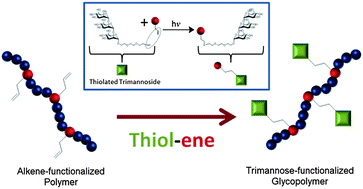Polymer–trimannoside conjugates via a combination of RAFT and thiol–ene chemistry†
Abstract
We report the successful conjugation of a bioactive thiolated α(1,2)-trimannoside to a

* Corresponding authors
a
Department of Bioengineering, University of Washington, Seattle, Washington, USA
E-mail:
stayton@uw.edu
Fax: +1 (206)616-3928
Tel: +1 (206)685-8148
We report the successful conjugation of a bioactive thiolated α(1,2)-trimannoside to a

 Please wait while we load your content...
Something went wrong. Try again?
Please wait while we load your content...
Something went wrong. Try again?
D. Roy, B. Ghosn, E. Song, D. M. Ratner and P. S. Stayton, Polym. Chem., 2013, 4, 1153 DOI: 10.1039/C2PY20820B
To request permission to reproduce material from this article, please go to the Copyright Clearance Center request page.
If you are an author contributing to an RSC publication, you do not need to request permission provided correct acknowledgement is given.
If you are the author of this article, you do not need to request permission to reproduce figures and diagrams provided correct acknowledgement is given. If you want to reproduce the whole article in a third-party publication (excluding your thesis/dissertation for which permission is not required) please go to the Copyright Clearance Center request page.
Read more about how to correctly acknowledge RSC content.
 Fetching data from CrossRef.
Fetching data from CrossRef.
This may take some time to load.
Loading related content
